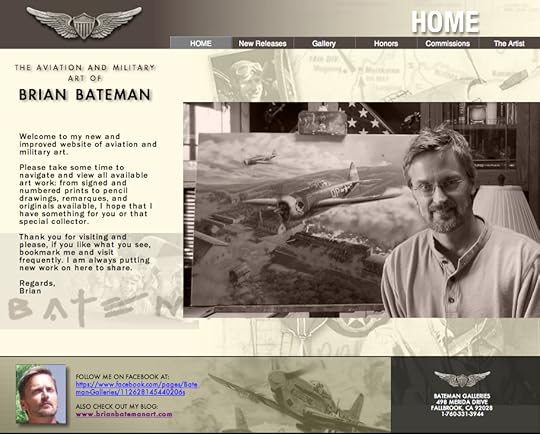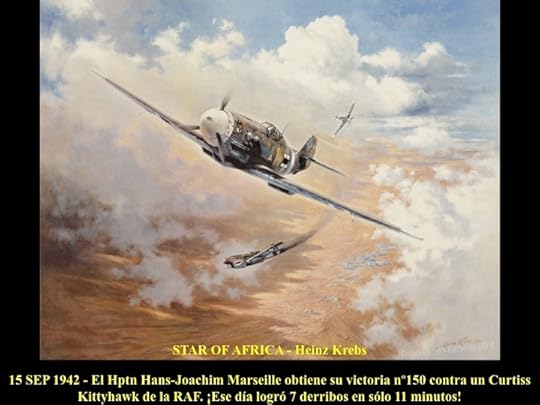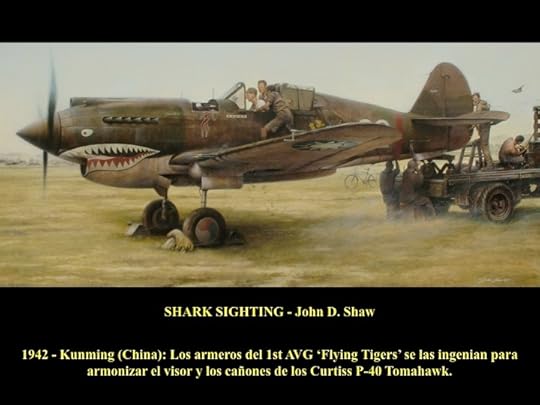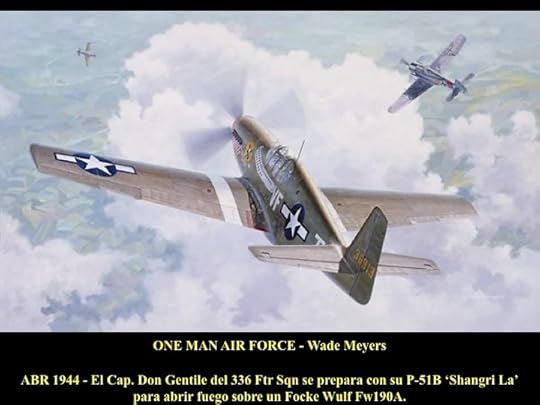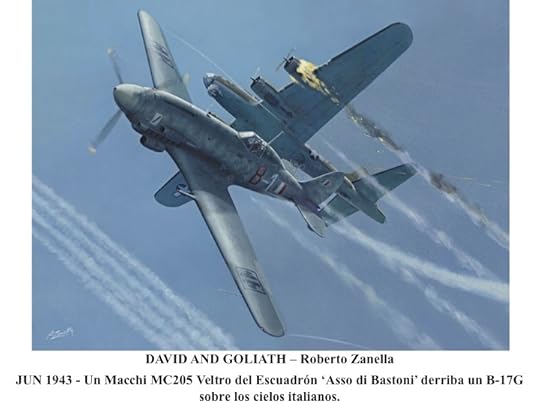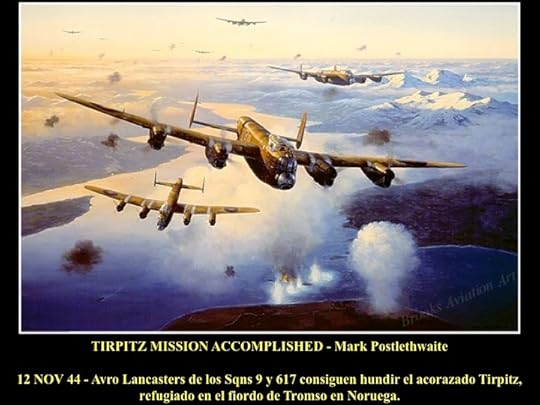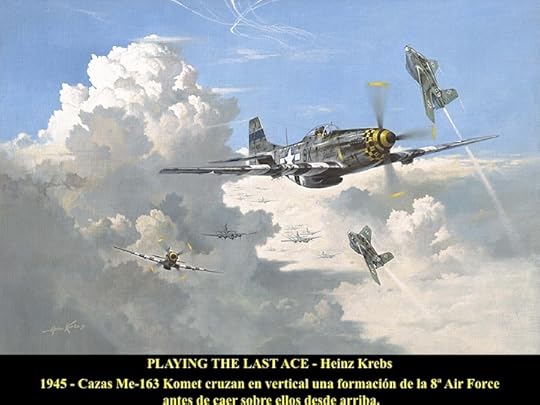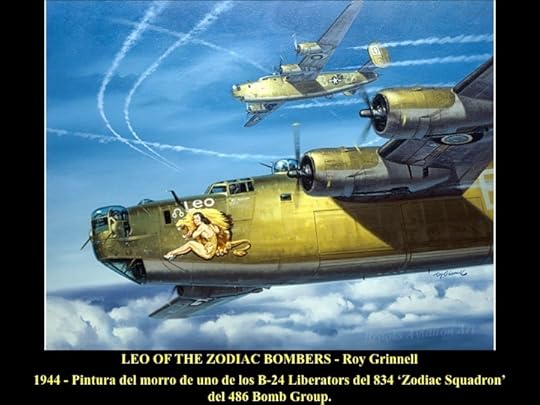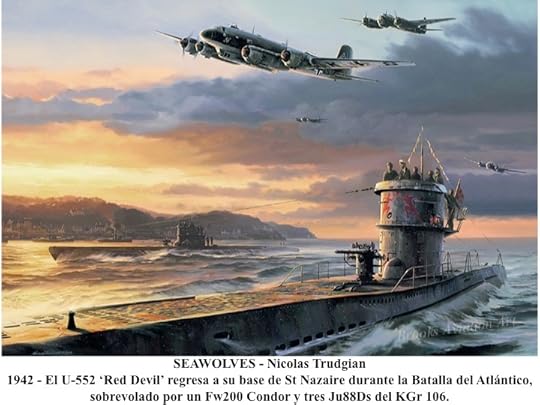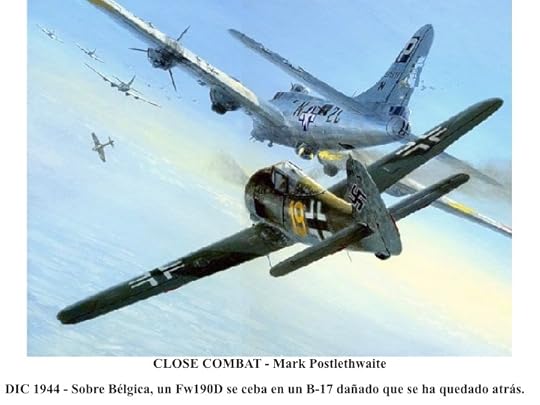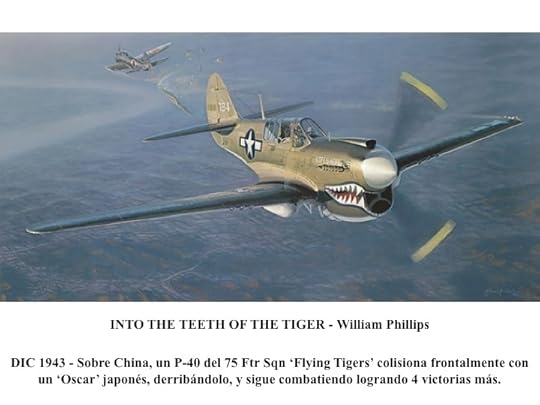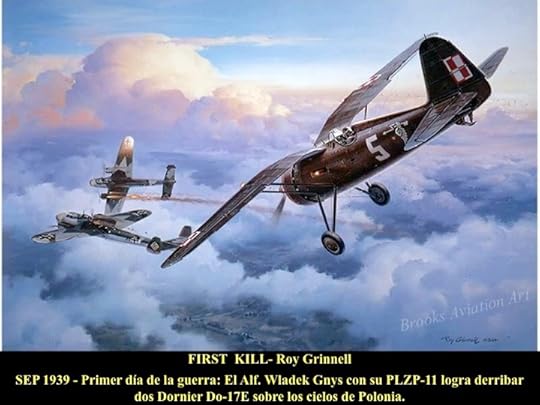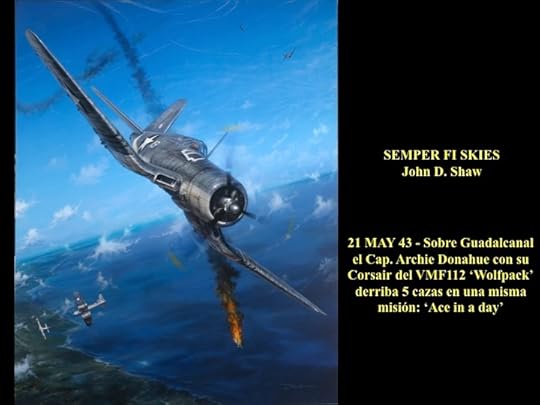Tosh McIntosh's Blog, page 9
August 17, 2012
Beautiful Aviation Art Lives!
If you have visited this logbook in the past and read any of the parts in the series “Beautiful Aviation Art,” you are probably aware that my sole purpose in posting the images is to pay tribute first to the airmen, and second to the artists who so wondrously capture single moments in the time of a world conflict almost beyond imagination.
In Part Four, I mentioned that the originator of the slide show with these images stumbled upon my website during an online search on a totally unrelated topic, and realized that we had flown Phantoms together in the 1970s. Forty years later we reconnect, and how cool is that?
Then yesterday I received notification of a new comment on Part One of the series from a visitor named Brian Bateman. He wrote:
Stumbled upon your blog and knowing many of these artists as my friends it is a pleasure to see their work posted and getting the recognition they deserve. Keep up the good work and I will look forward to your next set being posted in the future.
The comment included a link to Brian’s website, so I took a peek and discovered that he is the “real deal” when it comes to aviation and military art. If you are at all interested in this subject, I highly recommend that you pay him a visit and please mention that I sent you. Brian Bateman’s links are:
August 15, 2012
Beautiful Aviation Art–Part Five
We continue with the six-part series to showcase some of the finest examples of art depicting events of the WWII air war. I discovered the original images in a gorgeous slide show created by a good friend and fellow fighter pilot, Yago F. de Bobadilla, who rose to the rank of Major General in the Spanish Air Force.
Hauptmann Hans-Joachim Marseille, better known as the Star of Africa, was probably the most formidable opponent the British ever encountered in the air. He was victorious in 158 aerial combats against the Royal Air Force, 154 of which were fighter aircraft.
Marseille died undefeated whilst bailing out of his Me 109, which had developed an engine problem on the return leg of an uneventful sortie.
Marseille is seen here at the moment of his 150th aerial victory on September 15th, 1942. On this day, he fought and defeated no less than seven Curtiss Kittyhawk fighters in an incredible eleven minutes.
1942 – Kunming, China. Before the pilots of the legendary 1st American Volunteer Group “The Flying Tigers” could take to the skies against the enemy, the all-important task of boresighting the .30 caliber wing guns of their P-40′s had to take place. The ingenious armorers of the AVG were often forced to improvise, but as the Tigers’ incredible combat record can attest, these great Americans got the job done! Artist John D. Shaw has recreated this scenario, featuring likenesses of actual AVG personnel, such as “Tex” Hill and armorer Chuck Baisden.
Captain Don S. Gentile of the Debden-based 336th Fighter Squadron – 4th Fighter Group (8th Air Force) maneuvers his North American P-51B-7-NA Mustang “Shangri-La” while engaging an FW-190A-7 on April 8, 1944. For his actions this day, Gentile was awarded the Distinguished Service Cross, America’s second highest award for valor in combat. General Dwight D. Eisenhower presented the award personally, and when introduced to the young fighter pilot, Eisenhower remarked, “You seem to be a one-man air force!”
The Junkers Ju87 Sturzkampfbomber, known to the British simply as the Stuka, had already acquired a deadly reputation across Europe, its siren screaming as the ungainly dive-bomber struck terror into the hearts of those below. In 1940 its pilots crossed the Channel with their grim-looking aircraft to terrorise the southern towns and ports of England. Robert Taylors painting Open Assault, depicts Hurricanes of 501 Squadron attacking a force of Ju87 Stukas as they dive-bomb naval vessels and installations in the port of Dover on 29 July 1940. High explosive bombs detonate within the sheltered anchorage as escorting Bf109s from JG51 race in to protect their lumbering charges. Four Stukas and two Me109s are dispatched, for the loss of just one RAF aircraft.
A Macchi MC205V “Veltro” fighter demolishes a B-17G Flying Fortress of the 15th U.S. Air Force over the Italian skies. This Veltro belonged to the first Scuadriglia Asso di Bastoni (Ace of Clubs) of the first Gruppo Caccia of the NRA (Aeronautica Nazionale Republicana), the Air Force of the newly formed Italian Social Republic, which remained faithful to Mussolini and continued to work with the Luftwaffe after the Italian surrender.
At the time of the armistice, 112 Italian Veltro fighters went to the Aeronautica Nazionale Republicana Mussolini, while another 37 aircraft of the same model went to the Italian Air Force co-belligerent on the side of the Allies. MC.205s of the Aeronautica Nazionale Republicana played a major role in defending Italy against the American B-17 Flying Fortresses and B-24 Liberators on the road to their targets in Germany, Yugoslavia and Italy, and gained a large number of victories against the new P-51 Mustang fighters. By the end of the war, Veltros of the Republican Nazionale had shot down a total of 58 Allied aircraft.
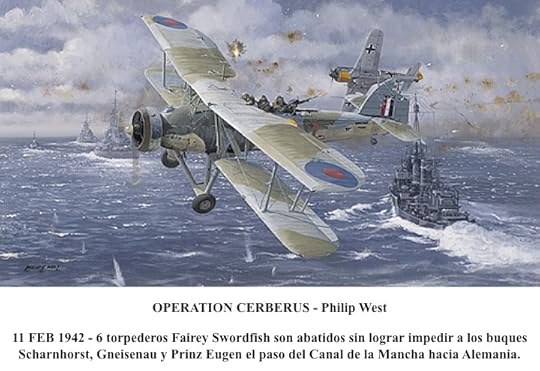 The Channel Dash (officially known as Operation Cerberus) was one of three operations during the Second World War for which the Fairey Swordfish was to become the most famous. Heavily outgunned in the Straits of Dover on this day in February 1942 by the German warships Scharnhorst, Gneisenau and Prinz Eugen, with their accompanying flotilla of destroyers and motor torpedo boats, and with top cover provided by deadly fighter aircraft of the Luftwaffe, all six Fleet Air Arm Fairey Swordfish were shot down. Only five of the eighteen aircrew survived. Here we see the Swordfish flown by Sub. Lt. Kingsmill and Sub. Lt. Samples with PO Bunce in the rear, fighting for their lives with his machine gun. The bravery of the Fairey Swordfish aircrew in this and all other operations is a matter of history and must never be forgotten.
The Channel Dash (officially known as Operation Cerberus) was one of three operations during the Second World War for which the Fairey Swordfish was to become the most famous. Heavily outgunned in the Straits of Dover on this day in February 1942 by the German warships Scharnhorst, Gneisenau and Prinz Eugen, with their accompanying flotilla of destroyers and motor torpedo boats, and with top cover provided by deadly fighter aircraft of the Luftwaffe, all six Fleet Air Arm Fairey Swordfish were shot down. Only five of the eighteen aircrew survived. Here we see the Swordfish flown by Sub. Lt. Kingsmill and Sub. Lt. Samples with PO Bunce in the rear, fighting for their lives with his machine gun. The bravery of the Fairey Swordfish aircrew in this and all other operations is a matter of history and must never be forgotten.
During World War II, the German battleship Tirpitz became the scourge of Royal Navy. Although she had been damaged in attacks by Royal Navy midget submarines and carrier-borne aircraft of the Fleet Air Arm, she remained a serious threat after being moved into a fjord in northern Norway where she threatened the Arctic convoys and was too far north to be attacked by air from Great Britain.
The task of sinking her was given to Avro Lancasters of No. 9 and No. 617 Squadrons, who operated from a staging base in Russia to attack Tirpitz with Tallboy bombs. They damaged her so extensively that she was forced to head south to Tromsø fjord to be repaired. This fjord was in range of RAF Avro Lancaster bombers operating from Scotland, and from there, in October, she was attacked again, but cloud cover thwarted the attack. Finally on 12 November 1944, the two squadrons of Avro Lancasters attacked Tirpitz, capsizing her. All three RAF attacks on Tirpitz were led by Wing Commander JB “Willy” Tait, who had succeeded Wing Commander Cheshire as CO of No. 617 Squadron in July 1944.
The Messerschmitt Me-163 rocket fighter aircraft, perhaps better known as the Komet, was possibly the most radical German manned fighter aircraft design to actually enter the WW II combat theatre. Here Me-163 Komet fighters of the Luftwaffe climb vertically through an 8th Air Force bomber formation and its top fighter cover before swooping down on the heavies for their short but often deadly attack.
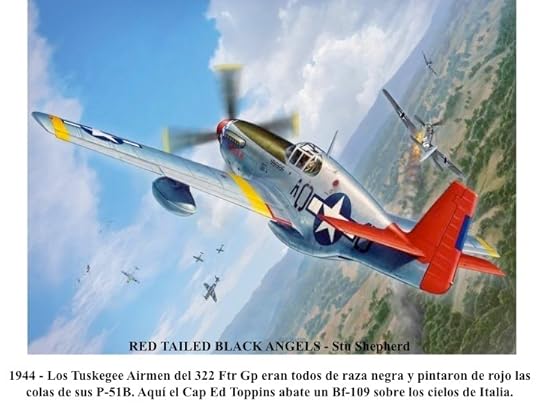 Artist Stu Shepherd captures the moment in which a P-51B Mustang flown by Capt. Ed Toppins of the 322 Fighter Group shoots down a Bf-109 in the skies of Italy in 1944.
Artist Stu Shepherd captures the moment in which a P-51B Mustang flown by Capt. Ed Toppins of the 322 Fighter Group shoots down a Bf-109 in the skies of Italy in 1944.
This unit, born of the racist society of America in the ’40s, was an experiment to determine if blacks were capable of flying planes and successfully engaging the enemy. The “Tuskegee Airmen” demonstrated that well in spite of the difficulties both at home and abroad, specializing in the role of bomber escort during hazardous daytime raids over the heart of Europe. Grateful bomber crews coined the nickname ”Red Tailed Black Angels” from the bright red tails of their Mustangs. By the end of the war, Tuskegee Airmen had scored a total of 109 enemy aircraft shot down at the cost of 150 pilots killed in action.
August 14, 2012
How Far Does a Good Guy Go?
Imagine yourself as a British soldier standing in a line with your mates, all of you wearing bright red coats, while the colonials are concealed in the forest with their long guns picking you off one at a time. What a cowardly thing to do. The rebels should come out and fight like honorable men.
Would the American Revolution have turned out any differently if the British generals had taken the time to jettison their stuffiness long enough to question why in the name of the King should they be standing there at the wrong end of a shooting gallery?
Fast forward to current day. Men and women of the United States military serve, shed flesh and blood, and die on foreign soil fighting an enemy who doesn’t play by the rules. The rules are ours, of course, forged into the backbone of America on the basis of certain principles we hold dear as a nation.
If we compare this conflict to a prize fight, it’s as if we are wearing gloves facing a bare-knuckled adversary. And like the British generals of the 18th century, we might consider whether it’s time to take off the gloves.
But we’re the good guys. To fight an elusive opponent might require getting our hands dirty. And this is supposedly a democracy, a system of government by the whole population or all the eligible members of a state, typically through elected representatives, so the citizens of the United States should be given the chance to be heard on the matter before we do it, right?
But taking off the gloves isn’t pretty. It breaks the rules we supposedly live by. What do we do about that?
Part of our answer as a nation is to fight fire with a blowtorch in a campaign known as enhanced interrogation techniques. Translation: torture. But the good guys don’t do that, so the answer has to be kept secret from the people for whom it is being done.
Abu Ghraib removed the clandestine lid, certainly, and another stinking pot is currently being revealed. Here’s an article with background information that might trigger in you a series of questions: How does this make me feel? Am I outraged? Am I a supporter of the methods even if they are made public? Or is it okay, just don’t tell me about it?
If you’d care to entertain these questions, please take a few moments to read on.
Poland peels back layers on secret CIA prison for suspected terrorists
By Roy Gutman , McClatchy Newspapers, August 13, 2012
STARE KIEJKUTY, Poland — On an idyllic lake surrounded by woods and a double row of mesh-and-razor-wire fences about 100 miles north of Warsaw, there stands a secluded villa that the CIA once used to interrogate — and allegedly torture — top al-Qaida suspects.
On the grounds of the Polish intelligence-training academy and nicknamed “Markus Wolf” for the former East German spy chief, it’s the focal point for a top-secret probe that Polish prosecutors have launched into how their government tolerated rampant violations of international and Polish law.
If former officials are brought to trial, or if the stacks of classified files in the prosecutors’ offices are made public, the result will be revelations about an American anti-terrorism operation whose details U.S. officials are fighting to keep secret.
Already the prosecutor has charged Zbigniew Siemiatkowski, Poland’s former interior minister and intelligence chief, with unlawful detention and corporal punishment for allowing the CIA to operate at Stare Kiejkuty from December 2002 to September 2003.
And the prosecutor’s office has given victim status in the case to two men the U.S. is holding indefinitely at Guantanamo: Abd al-Rahim al-Nashiri, a Saudi charged with masterminding the bombing of the USS Cole in Yemen in 2000, and Abu Zubaydah, whom the Bush administration once described as the third-ranking leader of al-Qaida but who may have been only a safe house minder. Al-Nashiri faces a possible death sentence; Abu Zubaydah, who’s been held for 10 years, hasn’t been charged.
Their status as victims comes from claims that they were kidnapped by U.S. authorities, brought to Poland illegally, tortured, then spirited from Poland to other detention centers without the legally required extradition proceedings.
The villa cannot be seen from the main road or spotted on Google Earth maps. At the request of Polish authorities, its location has been blurred, the Polish newspaper Gazeta Wyborcza reported.
That’s what some parts of the Polish government would like to have happen to everything that took place here.
State prosecutors, on the other hand, seem motivated to bring the case to court. The Polish investigation is now in its fifth year, has twice been reassigned to new prosecutors and will run at least until mid-February, it was announced last week. It is, to date, the only criminal prosecution in the world related to the CIA’s so-called “black sites.” The Obama administration has declined to investigate what happened at any of the sites, which included facilities in Thailand, Romania and Lithuania.
The prosecution is slow-going, but serious, according to Mikolaj Pietrzak, the Polish legal counsel for Guantanamo detainee Nashiri. The two prosecutors, Katarzyna Plonczyk and Janusz Sliwa, specialize in organized crime and counterterrorism and are “very capable, very competent,” said Pietrzak, who’s a former senior staffer of the Helsinki Foundation for Human Rights. His costs are borne by the Open Society Institute Justice Initiative, a U.S. foundation.
“The prosecutor is working very robustly. It is a very broad and thorough investigation — which doesn’t mean it’s effective,” he said in an interview in Warsaw. “Everything … could have been done much, much quicker.”
The prosecution has interviewed 62 witnesses and compiled 20 volumes of material, the Helsinki Foundation said.
Pietrzak has yet to see all the documents that have been collected in al-Nashiri’s case. He’s been allowed to see unclassified files in Krakow, but he’s had only fleeting access to the classified documents — under a previous prosecutor. But what he’s seen convinces him that his client was terribly mistreated in the villa.
“My analysis of those papers has removed any shred of doubt as to the accuracy of statements made in our application” for victim status, he said.
Some of what took place here is already known. According to declassified U.S. documents, al-Nashiri was threatened with a mock execution by power drill and handgun early in his seven-month stay at Stare Kiejkuty. Abu Zubaydah was waterboarded and subjected to other so-called “enhanced interrogation techniques.”
Other prisoners were very likely held here and treated in a way that Polish law prohibits.
Khalid Sheikh Mohammed, the accused architect of the Sept. 11, 2001, terrorist attacks, was waterboarded 183 times in March 2003, declassified Bush-era documents have revealed. That treatment came at a time he was probably in Poland, said Irmina Pacho, of the Helsinki Foundation’s “strategic litigation” program. But Mohammed is representing himself at Guantanamo, so there’s no way lawyers can plead for him here.
It’s difficult to gauge the likelihood that all facts will be made public. The Polish political elite are clearly ambivalent about prosecuting former officials, and the U.S. government has stonewalled all known requests for assistance, Polish lawyers say. At Guantanamo, the U.S. government has insisted that information about al-Nashiri’s treatment be kept secret. His Pentagon defense attorneys and a group of American news organizations are challenging the idea that al-Nashiri’s treatment must be considered “classified” and kept secret. The military commission judge will consider the issue at Guantanamo next week during hearings in the 9/11 case.
Poland’s president, Bronislaw Komorowski, called in May 2011 for a “thorough investigation” rather than excuses about “loyalty to an ally.” But four months later he refused to release his predecessor, Aleksander Kwasniewski, from his pledge to secrecy on state security matters when the prosecutor wanted to question him.
Kwasniewski, who in 2008 denied that there was ever a secret CIA prison in Poland, opposes the prosecution. In an interview with McClatchy Newspapers, he said that if anyone were to be prosecuted, it should be Americans, not Poles.
“Calling to account someone in Poland” for cooperating with the U.S. is “inappropriate,” he said.
Leszek Miller, the left-of-center prime minister at the time the CIA center was operating, has refused to comment on the secret prison. But Donald Tusk, the right-of-center current prime minister, talks tough.
“This is not the 19th century, and this is not some Bantu-stan,” he said in late March, after Siemiatkowski was indicted. “This case has to be resolved. Let there be no doubt about that either in Poland or on the other side of the ocean.”
For Tusk, the moment of truth is nigh. Last month, the European Court of Human Rights ordered Poland to explain by Sept. 5 why al-Nashiri and Abu Zubaydah have been given victim status and to provide the court with all agreements that pertain to the setting up of what the court called “a secret CIA prison” on Polish territory.
Still, there’s much that’s unknown about what happened in the Markus Wolf villa: the role of outside contractors in the prison’s day-to-day operations, the discussions between intelligence agencies that led to the establishment of the prison and what the Poles received in return, if anything, for allowing the black site to operate.
Evidence emerges in bits and pieces, in newspaper reports, in cryptic utterances from the state prosecutor and in the revelations of Jozef Pinior, a member of the Polish Senate and the European Parliament, who’s the one senior politician who’s consistently championed the case. In June, he said he’d seen an order to build an iron cage and deliver it to the villa.
His newest anecdote about the CIA prison centered on a note he’d seen from Polish intelligence officials to CIA personnel at the intelligence compound. It urged them not to throw any more kielbasa or Polish sausage in the trash, lest people think that Muslims are being held at the Stare Kiejkuty villa. “It is a clear message for people in the village that people are being held there.”
Journalist Adam Krzykowski, who in 2009 discovered many of the flight records and a computer hard disk that had eluded previous investigators, estimates that six to eight suspects, at most 11, were detained at Stare Kiejkuty. Altogether, there were seven special CIA flights to Szymany, an airport about 15 miles away, according to the flight records Krzykowski turned up, with the first arriving from Bangkok on Dec. 5, 2002, with seven passengers, and the last one out in September 2003 with five passengers.
Ironically, it was an official visit to Poland by President George W. Bush in June 2003 that led to the closing of the villa. Bush’s thanks for Poland’s cooperation in the war on terrorism were “so profuse” that the Polish president, Kwasniewski, realized “something was not right,” Gazeta Wyborcza reported in June 2011. He ordered an investigation, and on learning that the CIA was flying suspects into Poland for interrogation, ordered the interrogation center closed.
Where the prosecution goes from here isn’t clear. Pietrzak, al-Nashiri’s Polish attorney, thinks the Tusk government wants to string out the process. “If they charge someone there will be an eruption,” he said.
But others think that however long it takes, the Polish investigation won’t go away.
“For better or worse, there have been too many leaks about what is going on inside that prosecution,” said Crofton Black, a senior investigator at the British prisoner advocacy group Reprieve. “Even if it weren’t very difficult to walk away at this stage, so many documents have been sent to or seen by the prosecutor, so much is in the public domain. The cat’s out of the bag now.”
August 13, 2012
FIght ‘Til You Die–North Vietnamese Air Combat Details
I received the following article from a friend and fellow military pilot and decided to share it on my website because it presents information about an example of air combat in which a much smaller defensive force achieved impressive successes against overwhelming numerical superiority.
Adolf Galland, head of the German Fighter Command during WWII, is (roughtly) quoted as saying, “Only the spirit of attack born in a brave heart can ensure victory in a fighter aircraft no matter how advanced it may be.”
The quote certainly applies to the following example of dedication and bravery in the cockpit combined with brilliant tactical exploitation of enemy weaknesses.
The email I received with the article includes personal comments from two military aviators referring to a period of the air war over Vietnam in which the F-102 “Delta Dagger” (more commonly called the “Deuce”) of the Air Defense Command was sent into combat. As a foreword to the original article, I will only address the key points contained in the emails.
As you will see later in this post, two primary capabilities of a fighter determine how it should be most effectively employed against any given adversary.
First is the combination of thrust and wing loading, which define the ability of the aircraft to accelerate, use the vertical (i.e. climb or descend), and perform what is called the “quickest/tightest turn.” You can think of it as agility in a fight and the ability to get out of one in a hurry if need be.
Second, what kind of air-to-air armamant can the fighter carry? Guns, missiles, a combination of the two? Are the missiles guided by radar or infra-red? Are they contact or proximity fuzed?
Aerodynamically, a delta-wing aircraft like the Deuce has very good turn performance. The bad news is that it will shed airspeed very quickly in a hard turn. Without going into details, the Deuce was a relatively agile airplane in relation to the MiGs flown by the North Vietnamese, but once slowed down, it wasn’t particularly good at disengaging. Combine that with no gun and contact-fuzed missiles designed to engage lumbering bombers, the Deuce began any fight over North Vietnam at a distinct disadvantage. And further, combine that reality with stupidity in the cockpit, and you get the results my aviator friends referred to in the emails.
I’ve edited the following for brevity and to remove the names and a bit of language fighter pilots often use for “emphasis.”
It so happens that the F-102 flight lead who went after a MiG was an arrogant, miserable, glory-seeking idiot and squadron mate of mine before the war. He led his poor wingman to a predictable death. A Deuce may be able to maneuver with a MiG, but not shoot it down with those contact fuze missiles the Deuce carried. Getting near a MiG is a recipe for disaster. The leader’s hunt for glory caused his wingman to die. He should have been court martialed.
I never saw a Mig all the time that I spent over North Vietnam, but there were plenty around us. Our long-range radar guys were calling them out constantly. A couple of Navy A-1s killed a MiG in a head-on attack early in the war, so the bad guys stayed away from us. We could turn around in a phone booth and had 4 20mm [cannon] to point at them. Also, we gave off a poor IR signature so they had to try to gun us.
Having said that, my roomate in Thailand didn’t return from a mission over North Vietman. His flight lead did not see him get shot down and it was thought that he was lost to ground fire. Later, US sources said it was a MiG.
The term “ace” has a number of meanings depending on context. It can refer to a playing card with a single spot on it, ranked as the highest card in its suit in most card games. Informally, it’s a hole-in-one in golf, or a person who excels at a particular sport or other activity, and in tennis and similar games, a service that an opponent is unable to return and thus wins a point.
In military aviation, an ace refers to a pilot who has shot down many enemy aircraft, usually five or more. From WWI through today, the list of aces from many countries includes legendary names that resonate with aviators and non-flyers alike, and except for the Vietnam air war, most could match a particular name with a given conflict.
According to most sources, the final pilot ace totals were two American, one Soviet Union, and sixteen North Vietnamese. Considering the overwhelming superiority of American airpower during the entire conflict, the numbers appear blatantly inaccurate. They aren’t, and the article explains why.
And now the article, subtitled “From the Other Side of the Coin.” (Note: the following text has been edited for brevity and clarity.)
Nguyen Van Coc of the Vietnam People’s Air Force (VPAF) is the top ace of the Vietnam war with 9 kills: 7 aircraft and 2 UAV (Unmanned Airborne Vehicle) “Firebees.” Among those seven US aircraft, six are confirmed by US records, and we should add to this figure a confirmed USAF loss, the F-102A flown by Wallace Wiggins [KIA] on February 3 1968, originally considered a probable by the VPAF. His seven confirmed kills qualified Coc as the top ace of the war, even after omitting the downed UAVs.
Why so many Vietnamese Aces? And why did so many VPAF pilots score higher than their American adversaries? Mainly because of their numbers and tactics.
In 1965, the VPAF had only 36 MiG-17s and a similar number of qualified pilots, which increased to 180 MiGs and 72 pilots by 1968. Those brave six-dozen pilots confronted about 200 F-4 Phantoms of the 8th, 35th and 366th Tactical Fighter Wings (TFWs), about 140 F-105 Thunderchiefs (“Thuds”) of the 355th and 388th TFWs, and about 100 USN aircraft (F-8s, A-4s and F-4s) which operated from carriers on “Yankee Station” in the Gulf of Tonkin, plus scores of other support aircraft (EB-6Bs jamming, HH-53s rescuing downed pilots, Skyraiders covering them, etc.)
Considering such odds, it is clear why some Vietnamese pilots scored more than the Americans. Simply put, they were busier than their US counterparts. And unlike American pilots, who generally finished a tour of duty with 100 combat sorties and rotated home for training, command, or flight test assignments, VPAF pilots flew until they died. (Some US pilots requested and received additional combat tours, but they were the exceptions.)
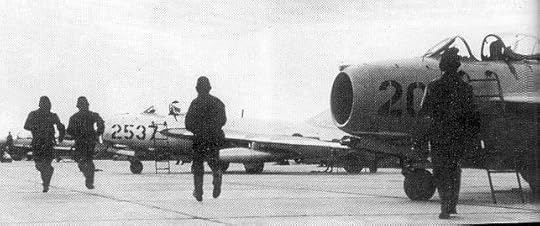 North Vietnamese pilots run towards their MiG-17s to engage US aircraft
North Vietnamese pilots run towards their MiG-17s to engage US aircraft
What about the tactics of both sides? Worried about killing Russian or Chinese advisers, higher headquarters did not allow US air combat forces to attack the North Vietnamese main radar installations and command centers. This provided the North Vietnamese with a significant tactical advantage because VPAF pilots flew their interceptors with superb guidance from ground controllers, who routinely positioned the MiGs in perfect ambush battle stations.
The MIGs made fast and devastating attacks against US formations from several directions. Slower MiG-17s performed head-on attacks and the faster MiG-21s attacked from the rear. After shooting down a few American planes and forcing some of the F-105s to drop their bombs prematurely, the MiGs did not wait for retaliation. They disengaged rapidly, and this guerrilla air warfare proved very successful.
Such tactics were augmented by less-than-effective American practices. Day after day in late 1966, for example, F-105 formations launched at the same times, used the same call signs, and flew the same flight paths to and from their targets. The North Vietnamese took advantage of this predictability in many ways, culminating in December, 1966, when MiG-21 pilots of the 921st Fighter Regiment (FR) intercepted the F-105s before they were joined by their F-4 escorts, downing 14 F-105s without suffering any losses.
Retaliation turned the tables on the North Vietnamese on January 2, 1967, when Col. Robin Olds executed Operation “Bolo,” in which F-4s mimiced the F-105 strike force and lured the MiGs into a trap with teeth.
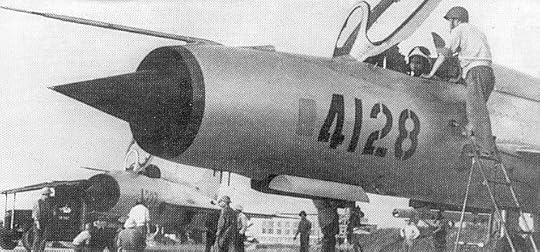 North Vietnamese ground crews prepare 2 MiG-21′s for air combat
North Vietnamese ground crews prepare 2 MiG-21′s for air combat
What about training? In the mid-1960s, American pilots were focused on the use of air-to-air missiles like the radar-homing AIM-7 Sparrow and infra-red guided AIM-9 Sidewinder. They had forgotten, however, that a skillful pilot in the cockpit was as important as the weapons he uses.
[Note: With due respect to the original author of this article, this is not an accurate representation of why air-to-air missiles had become the primary weapon for air combat. As is so often the case, the powers that be sitting behind desks had made the erroneous conclusion that in the modern age of jet fighters, the gun had been rendered obsolete. From personal experience in the cockpit at the time, I can attest to the fact that pilots at the pointy end of the sword did not agree with that assessment.
I wish I'd said this, but I have to give credit to a fellow fighter pilot, who likened a dogfight between an F-4 armed only with missiles and a MiG with machine guns and a cannon to a knife fight in a phone booth between an adversary carrying a sabre and the other with a dagger. We fought that battle over tactics for years and finally won, but not until late in the air war in Vietnam.]
The VPAF knew that, and trained its pilots to exploit the superb agility of the MiG-17, MiG-19 and MiG-21 by getting into close combat, where the heavy Phantoms and Thuds were at a disadvantage. Only in 1972, when the “Top Gun” program improved the skills in aerial combat of USN Phantom pilots and the USAF F-4E appeared with a 20 MM built-in Vulcan cannon, could the Americans neutralize that North Vietnamese edge.
A final comparison to explain the number of VPAF aces compared to those of the US may seem contradictory, but the overwhelming numerical superiority of US air combat forces meant that from the point of view of the North Vietnamese pilots, the aerial battlefield was a “target rich environment.” American airmen, however, could not find enough enemy aircraft to pile up large scores simply because there weren’t that many MiGs around. The VPAF never had more than 200 combat aircraft, only a fraction of which would be airborne at any one time.
These factors created more Vietnamese aces than American and provided opportunities for a few of those to pile up bigger scores than their American counterparts. Officially, of the 16 VPAF Aces during Vietnam War, 13 were MiG-21 pilots, and three were MiG-17 drivers.
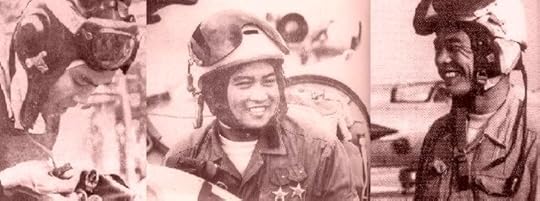 VPAF Aces Nguyen Van Bay ( 7 kills ) and Nguyen Van Coc ( 9 )
VPAF Aces Nguyen Van Bay ( 7 kills ) and Nguyen Van Coc ( 9 )
Here are some accounts of deeds performed by those valiant pilots who faced the most powerful air force in the world in defense of their homeland, and who earned the respect of their enemies, the American airmen.
Col Toon: Readers familiar with American military aviation may have heard of the legendary North Vietnamese ace, Col. Toon (or Col. Tomb). Why is he not listed here?
Because he was precisely that: legendary. No Colonel Toon ever flew for the VPAF. He was a figment of the American fighter pilots’ imagination and ready-room chatter. “Col. Toon” also may have been shorthand for any good Vietnamese pilot, like the solo nighttime nuisance bomber in WWII called “Washing Machine Charlie.”
Nguyen Van Bay: When the 923rd FR was created on September 7, 1965, Nguyen Van Bay was one of the students chosen to fly the MiG-17F Frescos. His training ended in January, 1966, and soon the young Lt. Bay saw action against American aircraft.
On June 21, 1966, four MiG-17s of the 923rd FR engaged an RF-8A recce plane and its escorting F-8 Crusaders of VF-211. Even as the escorting Crusaders destroyed two MiGs, Nguyen Van Bay opened his score when he shot down the F-8E flown by Cole Black, who ejected and became a POW. Even more important, the VPAF pilots achieved their main goal. As Bay and his buddies distracted the escort, Phan Thanh Trung in the lead MiG shot down the RF-8A. The pilot, Leonard Eastman, was also taken prisoner.
A week later on June 29, Bay and three more MiG-17 pilots engaged American F-105Ds heading for the fuel depots in Hanoi, North Vietnam. Together with Phan Van Tuc, Bay surprised and shot down a Thud. His victim, the leader of the US formation, turned out to be Major James H. Kasler, a Sabre Ace during the Korean War with 6 MiG kills.
Bay’s greatest feat happened on April 24, 1967. Now a flight leader, he scrambled from Kien An airfield and led his flight of MiG-17Fs against a USN raid on the Haiphong docks. Bay closed on an unaware F-8C of VF-24 and broke it into pieces with a burst of deadly 37mm shells.
The F-8C, piloted by Lt. Cdr. E.J.Tucker, caught fire and crashed. Tucker ejected, was captured, and died in captivity. The escorting F-4Bs of VF-114 entered the battle and fired several Sidewinders at Bay, but his wingman, Nguyen The Hon, radioed a warning. Bay successfully evaded all the missiles, turned his MiG-17 towards one of the Phantoms and shot it down with cannon fire. Lt. Cdr. C.E. Southwick and Ens. J.W. Land ejected safely and were rescued.
The next day, April 25, Bay’s flight of MiG-17s scored again, shooting down two A-4s with no losses. Both kills were confirmed by the US Navy: Lt. C.D. Stackhouse became a POW and Lt JG A.R. Crebo was rescued.
Bay was awarded the Hero’s Medal of the Vietnamese People’s Army for his outstanding skill and bravery in combat and for his superb flight leadership.
In early 1972, this Vietnamese MiG ace and his buddy Le Xuan Di were trained by a Cuban advisor in anti-ship warfare. On April 19, 1972, they attacked the destroyers USS Oklahoma City and Highbee,which were shelling targets in Vinh City. While Bay caused only slight damage to the Oklahoma City, Le Xuan Di hit one of the Highbee’s stern turrets with a 500 pound bomb. It was the first air strike suffered by the USN 7th Fleet since the end of WWII.
Nguyen Doc Soat: One of the merits of the Vietnamese People’s Air Force was that the more successful pilots could transfer their combat experience to novice students. Assigned to the 921st FR as a MiG-21 pilot, Soat’s instructors were the hottest VPAF pilots in the outfit: Pham Thanh Ngan (8 kills) and the top Vietnamese ace, Nguyen Van Coc (9 victories). Soat couldn’t ask for better teachers. While he did not score kills at that time, he gained valuable experience.
Reassigned to the recently created 927th FR when Operation “Linebacker I” began in May, 1972, Soat was ready to show his abilities. On May 23rd he scored his first victory, downing a USN A-7B Corsair II with 30mm fire. His victim was Charles Barnett (KIA).
On June 24, 1972 two MiG-21s flown by Nguyen Duc Nhu and Ha Vinh Thanh took off from Noi Bai to intercept F-4 Phantoms attacking a factory in Thai Nguyen, North Vietnam. The American fighter escort reacted rapidly and headed towards them.
But those MiGs were only bait. Suddenly two MiG-21s of the 927th FR appeared, piloted by Soat in the lead aircraft and his wingman, Ngo Duy Thu. The MiGs took the escorting F-4Es by surprise. Soat downed the F-4E of Pilot David Grant and Weapons System Operator William Beekman with a heat-seeking R-3S Atoll missile. Both crewmen became POWs. Thu also caused the ejection of another Phantom crew. [Note: The original article gave no details and I haven't been able to determine how Thu did that.]
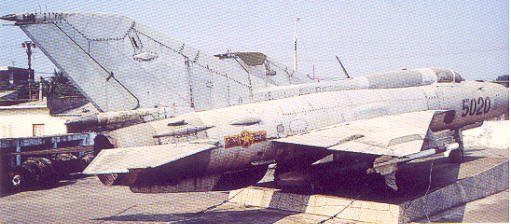 Nguyen Doc Soat scored some of his F-4 Phantom kills while flying the MiG-21
Nguyen Doc Soat scored some of his F-4 Phantom kills while flying the MiG-21
Three days later, Soat and Thu scrambled from Noi Bai and headed towards a flight of four F-4s. But they knew that eight more Phantoms were incoming, so they did not risk being sandwiched by the arriving US fighters. They turned back, climbed to 15,000 feet and waited.
Their patience was rewarded as they surprised the trailing pair of F-4s. Both Soat and Thu bagged one F-4E each with R-3 missiles. The crew of Soat’s victim was captured.
On August 26, 1972, Soat claimed the only USMC Phantom downed in air combat during the Vietnam War. The F-4J Radar Intercept Officer was rescued, but the pilot was killed. Soat scored his last victory on October 12, when he destroyed the F-4E crewed by Myron Young and Cecil Brunson. Both men were captured.
Along with Nguyen Van Coc and other VPAF vets, Soat is a living legend in the country for which he bravely and skillfully fought so many years ago.
Source: S. Sherman and Diego Fernando Zampini [abridged]
Other Sources:
Air War Over Vietnam, Dr. Itsvan Toperczer, Squadron/Signal Publications Inc., 1998
MiG-21 Units of the Vietnam War, Istvan Toperczer, 2001, Osprey Military
MiG-17/19 Units of the Vietnam War, Istvan Toperczer, 2001, Osprey Military
July 11, 2012
Beautiful Aviation Art – Part Four
In Part One of “Beautiful Aviation Art,” I introduced the planned six-part series by speculating that I knew the author. At the time, conjecture was my only option because I had not been able to confirm that he was in fact the same, the one and only, Yago F. de Bobadilla, a captain in the Spanish Air Force on an exchange-officer assignment with the United States Air Force at Luke AFB, Arizona, during my tour of duty there as an instructor pilot in the F-4 Phantom II.
But on May 14, 2012 I received the following email:
My dear friend (from 40 years ago) Tosh:
I still can’t believe I literally stumbled upon your webpage when I was surfin’ the net the other night, looking for something totally unrelated to the world of aviation. When I saw your name in the home page, it tickled my fancy making me wonder if it could really be you the guy I had been with during those wonderful years flying F-4Cs in the 426 TFTS at Luke AFB. Then I saw you in a couple of photos and, lo and behold, it was confirmed that yep, it was really you, my good friend from way back then!!!
But then my amazement peaked when I started browsing through your various Blog and Logbook pages, and in Single Ship I come upon a Post dated April 18, 2011 and titled BEAUTIFUL AVIATION ART – Part One. Out of curiosity, I opened the Post and….. Oh, my gosh!!!!…. there you are reminiscing about a Spanish Air Force fighter pilot you had befriended 40 years ago flying Phantoms in Arizona!!!
Tosh, you have one hell of an incredible memory to remember faithfully all those details about our great conversations together, after all these years. Well, yes here I still am, alive and well, and hoping to rekindle the good camaraderie we enjoyed during those three years.
If you read this mail, I hope you won’t trash it ’cause I have lots of stories to share with you. Plus I have updated (and improved) AVIATION ART - WORLD WAR II…..and I can email you AVIATION ART – THE JET AGE (it’ll blow your socks off).
Waiting to read your reply, your good Spanish friend
Yago Fernández de Bobadilla
Major General SAF (Ret)
Before I try to characterize my reaction at receiving the email, I need to offer an explanation in the form of a joke. It may seem off-point, but please bear with me.
A street bum walks into a bar and stands just inside the entrance, waiting politely to be acknowledged. The bartender recognizes the bum as a regular panhandler around town and has never had any trouble with him, but he still isn’t eager for the guy to be hanging around outside the bar, much less sitting on a barstool. “May I help you?” he asks.
“Yessir, I believe you can. I was standin’ on the corner at Seventh and Vine, that’s my usual spot, ya see, and this dude drives up in one o’ them fancy sport convertibles with the top down. Unlike most folks, he actually looks at me, then he apologizes ‘cuz he didn’t have no spare change. He must o’ seen my eyes glancin’ over to the two cases of wine sittin’ on the passenger seat, ‘cuz he smiles, opens the top o’ one, hauls out this here bottle and hands it to me.”
When the bum pauses in his story, the bartender says, “Well, that’s good, but what does that have to do with me?”
The bum sets the bottle on the bar, points at the top, with its dark red lead seal and cork. “Imagine my surprise.”
Okay, so if you get the point of that joke, you know how it felt to receive this email. Yago and I have communicated a few times since then, and I’ve been meaning to continue with this series as a tribute to him for gathering these paintings together in one place so I can share them with any visitors to the site who might be interested.
Without further procrastination, here is “Beautiful Aviation Art – Part Four,” by Yago F. de Bobadilla, Major General, SAF (Ret).
This image reflects the unique nose art of one of the B-24′s in the Zodiac Squadron. The original nose art was painted by Phil S. Brinkman while he was assigned to the Army Air Force Station 174 in Sudbury, England. Brinkman joined the Army Air Corps in the summer of 1942. He was assigned to Special Services, when he entered the army, since he was an accomplished commercial artist at the time. Shortly after he arrived at Davis-Monthan Airbase in Tucson, Arizona, he completed a large mural which attracted attention and was seen by the commander of the 834th Bomb Squadron, Captain “Jip” Howell, who set up a transfer to bring Brinkman into the 834th. The idea of adorning the B-24′s of Capt. Howell’s with unique nose art resulted in the famous “Zodiac Bombers” including “Leo.“
Captain Erich Topp steers his Type VIIc U-Boat number U-552 Red Devil towards the sanctuary of the base at St Nazaire after another patrol during the grueling Battle of the Atlantic in 1942. In the skies above, heading back out to hostile waters is a giant Focke Wulf 200 Condor from III/KG40 and three Ju88Ds from KGr 106 whose missions will be to search for vulnerable Allied shipping for the submarine Wolfpacks to attack. The third-highest scoring U-Boat ace, Captain Erich Topp sank a total of thirty ships and damaged three more whilst commanding the Red Devil.
This painting is aptly titled as it depicts Focke-Wulf Fw 190D-9′s of JG-26 intercepting B-24s high above Germany during the last months of the war.
Fw Wilhelm Hopfensitz of IV/JG3 piloting his Focke Wulf F190, closes in on a B-17 Flying Fortress of the 838th BS over Belgium, 23 December 1944.
4 June 1942: One of the defining moments of the Pacific War occurred when the tide turned against the Japanese aggressors at America’s Midway Islands. Lieutenant Richard H. Best and his two wingmen in their Douglas Dauntless SBD dive-bombers have just launched a successful attack on the Japanese flagship aircraft carrier Akagi. The crushing defeat inflicted on the Japanese Navy by the very much smaller United States Pacific Fleet at Midway put an end to Japan’s ambition to dominate the central Pacific region and removed the Japanese threat to Hawaii.
There’s more than one way to bring down an opposing fighter, as 1st Lt. Don Lopez learned on December 12, 1943. He and his comrades of the 75th Fighter Squadron were at 6,000 feet over South Central China when the young airman experienced his first scramble. Lopez ripped his P-40 into the middle of a flight of Japanese “Oscars” and quickly engaged one of them, flying directly at one another, firing steady hits. Lopez expected his opponent to break off, but neither did so. Head-on only a few feet apart, the Oscar swerved right … too late. Lopez lost three feet off the end of his wing, but the Japanese pilot lost substantially more, including control of his aircraft, which plunged toward the earth. Undaunted, Lopez pressed the attack again and scored enough victories to join the ranks of “ace” fighter pilot. (Tosh note: Let’s take stock of this for a moment. Lopez is a rookie on his first combat mission. He loses part of his left wing in a mid-air collision with a Japanese fighter and continues the engagement to down (probably with his guns) four more Japanese planes. Now that’s what being a warrior is all about.)
In the pre-dawn of September 1st 1939, units of Hitler’s Luftwaffe and Wehrmacht were poised to smash across Poland’s borders to begin WWII. At sunrise, formations of German bombers were over Krakow and attacked the Polish airbase of Rakowice. Meanwhile, several miles to the west on a secret airfield at Balice, 121 Fighter Eskadra (Squadron) of Army Krakow’s 2 Dyon (Air Regiment) was alerted to the attack by the noise of explosions and flaming horizon.
Leaping from his bed and pulling on his flight clothes, 28 year-old veteran flyer, 2nd Lt. Wladek Gnys, ran with his CO, Capt. Mieczyslaw Medwecki, to their gull-winged PZLP.11c fighters. As they took off to make an interception of the German attackers, the pair was surprised by fire from passing Ju-87 Stukas of I./StG2, and Medwecki was downed. In attempting to evade, Gnys went into a stall, but regained control just above the ground. Climbing once again, he managed to put two bursts into the engine of another Stuka, which turned away trailing a plume of smoke.
Later, at 5000 feet, Gnys spotted two Do-17E bombers of III/KG77 just above the rising early-morning fog. Putting his small fighter into a near-vertical dive, Gnys banked steeply toward the Dornier on the right and fired his four 7.7mm machine guns, silencing the rear gunner and hitting the port engine. He then climbed and banked to the left, away from his smoking victim, to pursue the second German. Attacking from the second bomber’s port side, Gnys dove and fired, getting hits on the cockpit. Realizing that the two mortally wounded Dorniers were on a collision course, he continued his dive below and away from them.
Returning to base, the victorious pilot did not see the two crashed bombers smoldering in a farmyard near the village of Zurada… the first victories over the Luftwaffe in World War II! Gnys later fought with the French Air Force in the Battle of France, the Royal Air Force in the Battle of Britain, and ended his combat career as the squadron leader of the 317F Squadron , RAF.
This scene depicts Corsairs of VMF-112 ‘Wolfpack’ in combat near Guadalcanal in 1943. On May 21, Captain Archie Donahue became an “ace in a day” by shooting down 5 enemy aircraft in one mission. He would repeat this feat 2 years later while serving aboard the USS Bunker Hill.
“Raid on the China Coast” depicts Lady Lil of the Air Apaches 345th Bomb Group, 498th Bomb Squadron. A B-25 is attacking Japanese shipping off the coast of China, April 1945. Pilot: Lt. Albert J. Beiga. The Raid was between Amoy and Swatow, west of Formosa.
July 9, 2012
Trials and Tribulations of Indie Publishing – Follow Up
I realize that a very small amount of middle ground exists when it comes to opinions about Amazon. People either hate them for being the harbinger of ultimate centralized control over everything we purchase, or love them for making online shopping better in any number of ways than buying local.
But I have to tell you that when it comes to dealing with authors whose books are listed for sale in their store, Amazon’s customer service is superb.
I posted a complaint/question about the information they provide authors with regard to requirements/recommendations for eBook cover images and received a reply about 24 hours later. It confirmed that uploading higher quality covers is encouraged.
Last night I re-sized the covers for my eBooks on Amazon, Barnes & Noble, and Smashwords even though I honestly believe that not one viewer in thousands can tell the difference or cares even if they do.
The decision came down to a simple question of whether I want my covers to appear at their best possible quality available on the display being used.
With the original 72 ppi versions, that was true only when being viewed on the web. Once downloaded with the book and viewed on a computer or color screen eReader, image quality very likely becomes the limiting factor.
My new 300 ppi versions, however, put the ball in the other guy’s court . . . at least until the next higher-resolution screen sails back across the net with more trials and tribulations of indie publishing.
July 8, 2012
Trials and Tribulations of Indie Publishing
Since making the decision to Go Indie and follow the advice of Dean Wesley Smith to Think Like A Publisher, I’ve been faced with a series of challenges, most of which have been accompanied by the element of surprise.
The newest arrived in a roundabout way via an email from Smashwords with a link to their blog and a post about the new cover image requirements soon to take effect.
For indie writers who hire someone to create their covers, this event will pass under the radar like an F-4 at 100 feet, masking behind a ridge line between the aircraft and a surface-to-air missile site. But for me, the head cook and bottle washer here at toshmcintosh.com, it means revisiting an issue I thought was over and done with.
 My initial attempt at creating a book cover involved opening Photoshop Elements for the first time. I wore out the ‘Undo” button within a couple of weeks and had to purchase a new copy of the software. After awhile the trials began to exceed the errors, and an eBook cover rose out of the detritus left over from all those false starts.
My initial attempt at creating a book cover involved opening Photoshop Elements for the first time. I wore out the ‘Undo” button within a couple of weeks and had to purchase a new copy of the software. After awhile the trials began to exceed the errors, and an eBook cover rose out of the detritus left over from all those false starts.
Elsewhere in this logbook I’ve written about this first effort and the ones that followed, so I’ll mention only that my standard image size for an eBook cover has been 600 pixels (px) by 800 pixels at a resolution of 72 pixels per inch (ppi). These dimensions and resolution were clearly stated in Amazon’s Kindle Direct Publishing guidelines.
For those of you who don’t know (and probably don’t care), suffice it to say that each pixel (also referred to as a dot) has a binary code assigned that represents one of millions of colors. The more pixels an image has determines how much color data can be contained in it. My first cover had a total of 2400 pixels available. If I were to print the image and select a resolution of 100 ppi, the result would be a physical size of 6″ x 8″, and it wouldn’t be very crisp. It would appear pixelated with jagged edges.
But I’m not printing the cover of an eBook, and the maximum resolution available on the web is 72 ppi, so this size image has worked well. Until now, apparently.
Smashwords distributes books to Apple’s iBookstore, so when Apple announced that new cover image requirements would be taking effect, Smashwords had to get the word out to all their authors. The explanation for the change, apparently, is Apple’s intention to improve the quality of eBook cover images on higher resolution screens.
To understand the crux of the issue, let’s recognize that when shopping online for an eBook (but not a specific one) the cover image is the most likely reason you pause to take a closer look. I choose to ignore a recent post by a well read blogger who opined that book covers were becoming irrelevant, and to embrace research that indicates eBook covers do make a difference. To take their importance lightly is a marketing mistake that serious indie authors do not make.
It’s also important to note that the previously standard resolution of 72 ppi refers only to viewing the cover on the web. Shoppers are looking at thumbnail cover images until they click on a cover of interest and it expands for a better view. It’s still presented at the same resolution, however.
The downloaded eBook file contains the cover image as well, and its quality is limited only by the lesser of two resolutions: that of the image itself or the screen on which it is viewed. I’m viewing this post on an Apple LED Cinema Display with dimensions of 2560 px x 1440 px. To determine the resolution, I divide these values by the physical dimensions of the screen and come up with 110 ppi. If the same number of pixels were crammed into a smaller screen, the resolution would increase proportionately.
Since Apple’s new requirements appear to be driving the requirement for better quality cover images, let’s look at a 3rd generation iPad. I don’t have one, but it didn’t take long to determine that the screen has a diagonal dimension of 9.7″, which equates to a rectangle of about 7.9″ x 5.7″. The pixel dimensions of the Gen 3 iPad are 2048 x 1536.
If you own an iPad, you’re well aware of the display quality. That might be a major reason why you bought it. What you may not know is that the Gen 3 iPad display has a resolution of about 260 ppi.
So how does my 72 ppi cover image appear on an iPad? Shortly after publishing Pilot Error, I viewed the eBook on a friend’s earlier generation iPad and was impressed by the quality of the cover image. Would I be able to tell the difference now if I were to resize the image and compare the new version with the old on his iPad?
As of this writing, I don’t know. What I do know is that although the new requirements for cover images do not apply to covers for eBooks already uploaded, I’m not going to be satisfied until I provide readers with the best cover image I can. Let the limitation be their viewing device, not the eBook.
Which means that one more item has just been added to my indie publishing “To Do” list. I’m going to resize the current covers and upload them, one at a time, even though I’m positive that no one else will notice or care much if they do.
But in the final analysis, that doesn’t matter, because I’ll know.
June 28, 2012
Red Line – The Backstory
Common advice to writers who are submitting to agents includes emphasis on the importance of having another novel in progress to distract you from your inbox. There’s a joke that will serve as a metaphor, and it goes something like this:
“Do you know why farmers and ranchers wear hats with the curled brim? It’s because they spend all their time with their heads stuffed into their mailboxes looking for those welfare checks.”
After finishing Pilot Error and polishing it into what I thought at the time was submission quality, I began sending out packages via snail mail to all the literary agents on my list. Taking the advice to heart, I refused to even think about the fact that at any given moment, an agent might be reading it. I’d planned from the beginning to write a series, so why not get started?
At 7:11 in the evening of Wednesday, April 13, 2005, I opened a new Word document and began writing the first scene. I’d already spent a few weeks in preparation and had many pages of notes on the basic storyline and the characters, including significant backstory events for the major supporting characters.
The protagonist’s backstory, of course, was contained in the 102,000 words of Pilot Error, and I knew that the writing of Red Line would require careful attention to a story element I hadn’t faced with the first novel. As opposed to a true sequel, such as the second and third novels in The Lord of the Rings, a second-in-series novel has to be a stand-alone story. I’d have to assume that some readers wouldn’t have read Pilot Error.
It’s hard enough to handle backstory effectively in a true stand-alone novel with a one-time protagonist. The author has to pay close attention to the following three questions: 1) What does the reader need to know from the period prior to page one? 2) When does the reader need to know it? 3) What is the best technique for inserting this particular event from backstory into current story time?
Writers talk of inserting backstory in info-bits rather than info-dumps, and the most common reason is to avoid the inevitable effect on pacing. Current story time screeches to a halt to accommodate the backstory. My post titled “Looking Back” in the “Wings On My Words” logbook addresses this problem and the various ways I think it can be dealt with effectively.
For Red Line, I had to blend in the protagonist’s key backstory elements from the first novel along with that of the new supporting characters, all of whom enter the stage with significant events from their own pasts that define who they are and dictate to a large degree what they are going to say and do in any given situation. Combining these backstory elements with the requirement to walk a tightrope between including too much or too little from the previous novel became a significant time-hog in conceptualizing how the second story would flow from the first and yet be independent of it.
With about 56,000 words written, I put Red Line on the shelf when my unsuccessful effort to obtain an agent for Pilot Error convinced me that I had more work to do. Now that it’s published, along with Book One of Wings On My Words, tales from the writer’s desk and Book One of Words On My Wings, tales from the cockpit, the time has come to dust off Red Line and reacquaint myself with the story so far in order to pick up where I left off.
This logbook will continue with tales from the writing of Red Line, scheduled for publication in the Fall of 2012. Please visit again soon and be on the lookout for the next episode.
June 19, 2012
A New Word
Language lives, breathes, morphs over time to reflect changes in culture, religion, technology, among other things, and, of course, politics.
Here’s a new word making the rounds, and I predict that it won’t take long for it to be recognized as the most accurate descriptor for what America has become.
(Click on the image for a larger view and use the back button on your browser to return to this page.)
June 15, 2012
Update From the Blogosphere
Blog design is an iterative process that in truth probably should never be considered complete. Posts in this Blogbook category present a series of lessons learned since launching the site in late July of 2010.
The primary purpose of toshmcintosh.com has been to establish an online presence in advance of publishing my first novel, Pilot Error. Up until last Fall, I’ve had nothing to offer for sale. But now, the underlying objective is to support the goal of getting the word out by taking advantage of marketing opportunities in the Internet universe.
Site navigation notes follow:
If you are reading this and the post title is in black, HOME in the menu bar below the header is darkened and all the previous posts are stacked vertically in reverse chronological order. The title is linked, so that clicking on it will open a new page dedicated to this post.
If the post title is shown in blue, Blogbook will be darkened in the menu bar and you are already in the dedicated-page view with posts arranged like the pages of a book. Posts can be reached by clicking on the left-arrowed link to “Older posts” or the right-arrowed link to “Newer posts” (if there are any).
The menu bar below the header image contains links to either pages or various categories of posts I call “logbooks.” Pages are static and present content that doesn’t change, such as “About Pilot Error,” “About Tosh,” “Site Navigation,” etc. Logbooks such as this “Blogbook” and “Single Ship” contain posts, with the newest always appearing on top of the stack.
“Reviews” is also a page, but hopefully it will not remain static. In the perfect world according to an author indie publishing a debut novel, readers will be compelled to write glowing, five-star reviews and recommend Pilot Error to their friends, who will also write good reviews. Using a Reviews page rather than a category with posts allows me to selectively edit the page and control the order rather than being forced into a chronological presentation. In plain language, I can keep the very best review on top no matter how many supersede it, or put the latest on top, or rotate them to alter the appearance of the page.
To the right of this “content area” where you are reading, customizable areas called “sidebars” appear with linked tools for navigating the site. The links are organized into “widgets.” The relatively cluttered sidebars of toshmcintosh.com are one reason I decided last fall to launch another blog dedicated to Pilot Error.
In retrospect, that wasn’t a good idea for a number of reasons: it’s hard enough keeping up with one blog; the second one won’t be filled with enough new content to be picked up by search engines for months to come; many posts are suitable for both blogs, so I ended up double posting them; and most important, am I going to launch a new blog for each book?
The decision to combine the two blogs has resulted in some changes to the parent toshmcintosh.com. I’ve reorganized the main menu bar just below the header image, redesigned the appearance of the header and what are termed “featured images” for some of the posts, and refined the widgets in the sidebar.
One of the decisions still in work is how best to include “buy now” links for my books. A common solution is to include cover thumbnails on the Home page with links embedded or as a caption below the thumbnail. With a website platform, this works well because the Home page is static. Once you position the thumbnails, they remain where they are and are visible immediately to a visitor.
But this is a website on a blog platform, which gives precedence to blogging and always places the newest content at the top of the stack of posts. The only way to position thumbnails so they are visible with no extra navigation steps is to put them in the sidebar. Even then, a visitor can view only the first few books before having to scroll downward.
Another important consideration when choosing this solution is that the widgets with links to pages and logbooks are shoved lower on the Home page. Visitors have to scroll to find the index for the primary purpose of this site, which is blogging.
For the time being, anyway, I’ve decided to dedicate the sidebars to blogging and include a “Where to Buy My Books” link in the main menu bar. This takes you to a dedicated page with a cover thumbnail and buy links for each book.
At the very bottom of any page on the site, four appropriately named “Footer Areas” allow more customization. I can repeat the widgets included in the sidebars, which puts the navigation links in a handy location for visitors when they reach the end of a post. I’ve thought about including cover thumbnails and buy links there, but that works only for the first four books.
Did I mention that blogging is iterative?

